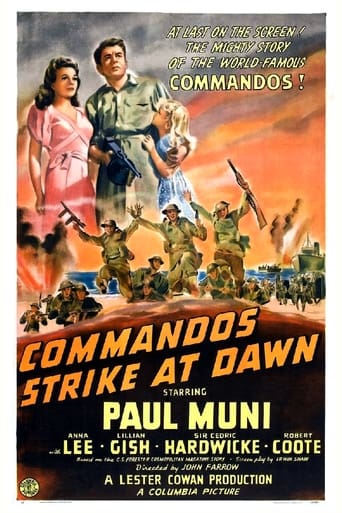GManfred
Reading the title, I'll bet you're waiting for a rip-roaring war picture, with fight scenes, explosions and guns blazing. But you would very mistaken, since this is a placid character study with a great deal of dialogue. There is a battle scene towards the end of the picture, but Director John Farrow was sorely in need of a competent second unit director. The battle has an artificial look to it and the explosions are small in scale. In one scene an allied soldier throws a Nazi to the ground, and plainly stabs the ground next to him, lending an amateurish quality to a heretofore passable film.The story itself is good and depicts the Nazi onslaught into Norway, in particular a small hamlet in a spot of strategic interest to the Nazis. The acting is top shelf, with Paul Muni, Anna Lee, Cedric Hardwicke and Robert Coote in prominent roles. There are a few instances of suspense and tension but none are sustained. It's a good movie - but not if you're looking for a conventional war picture. ****** 6 of 10
jjnxn-1
Its propaganda roots are obvious now but still a well acted war drama about the struggle of Norway against the Nazi machine. Paul Muni is strong in the lead. Famed for parts where he was under heavy makeup like Emile Zola and Louis Pasteur those performances viewed today are heavy and hammy whereas in plain clothes such as here and I Am a Fugitive from a Chain Gang he is far more naturalistic. A cast of fine character actors all add texture to the film. Lillian Gish's part is small and mostly without dialogue but of course she could convey more with a look than most actresses with a telephone book worth of words.
wes-connors
In 1939 Norway, peace-loving widower Paul Muni (as Erik Toresen) attends the wedding of a fisherman friend. There, he dances with leading lady Anna Lee (as Judith Bowen), daughter of visiting English admiral Cedric Hardwicke. She returns to England and Mr. Muni stays behind, only to witness wicked Adolf Hitler's Nazi forces invade his country. After the Germans demonstrate the expected brutality, Muni becomes a Norwegian resistance leader...This pedestrian World War II propaganda story is not complimented by its own rewards. The Canadian filming location is lovely and the cast inviting. Especially noteworthy is the big screen return of legendary Lillian Gish (as Hilda Bergesen) after ten years focused on stage work, but in too small a role; Ms. Gish only punctuates how "Commandos Strike at Dawn" adds up to so much less than it should. There is certainly enough here, however, to recommend the film.****** Commandos Strike at Dawn (12/30/42) John Farrow ~ Paul Muni, Anna Lee, Lillian Gish, Cedric Hardwicke
blanche-2
"Commandos Strike at Dawn," from 1942, is another propaganda that demonstrates the spirit of the Norwegians and their commitment to resistance. This one is directed by John Farrow, with a screenplay by a man whose name would become synonymous with long novels, Irwin Shaw, and stars Paul Muni, Anna Lee, Lillian Gish, Cedric Hardwicke, Alexander Knox, George MacCready, Ann Carter, Rosemary DeCamp, and Ray Collins.Based on a story by C.S. Forester, "Commandos Strike at Dawn" tells the story of more victims of Quisling, citizens of a small town that is taken over by the Nazis. After Eric Toresen (Muni) sees a friend murdered and another one (Collins) severely beaten, he gets some of the townspeople to form a resistance group. When he realizes that the Germans are preparing for a huge air strike against England, he is determined to get the information to the right people in England and join the fight.Very good film, if a little slow in spots. Muni gives an excellent performance as the bold Toreson, and Ray Collins, Lt. Tragg of Perry Mason, is cast against type as one who vocally opposes the Nazis, and he is very good. This was probably his favorite role, as it's so different from his standard tough cop or crooked politician role. Lillian Gish doesn't have much to do, sadly, as his wife. Neither does Anna Lee, as the daughter of a British military man (Hardwicke) who falls for Muni.Someone commenting here said that this film, and probably by inference, Edge of Darkness, exaggerates the role of the underground in Europe, that most Europeans were passive during the war, afraid of reprisal. That may have been true in some areas - Germany most definitely - but that was not true in France and Norway, both of which had formidable resistance movements. Some people don't like bullies.
